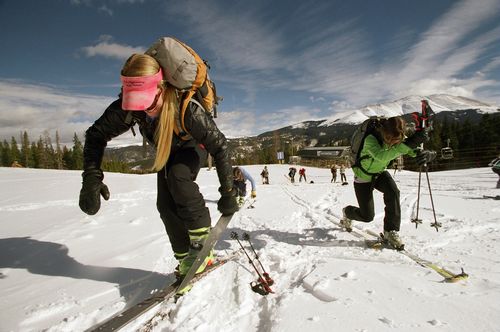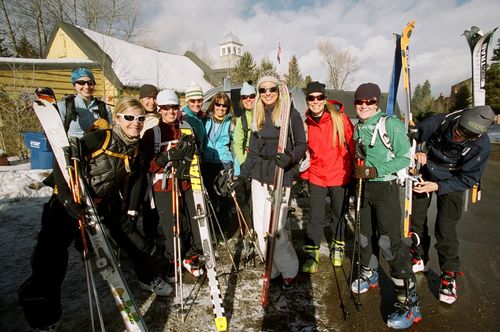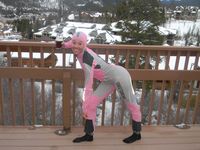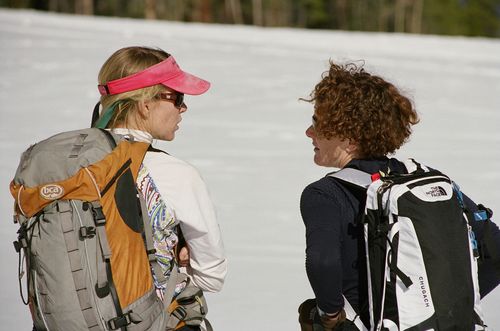
The only problem with ski mountaineering racing—or randonee if you want to get all Frenchy—is that barely any women in the US are doing it. Which begs the bigger question, why do women wait for men to embrace debilitating endurance sports before embracing them?
Consider skimo, wherein one gets the lightest alpine touring gear one can find and takes it into the backcountry to skin up a 12,000+ foot mountain and then immediately race back down. Then do it again. And again. And again. We women like the theory, but mostly we’ve watched the boys put it into practice while we decide if it’s worth it.��
That is, except for Monique Merrill. The 41-year-old Breckenridge native fits right in with the men in her hometown—where they wrote the Uphill Access Policy on ski mountaineering, created the in the US, and have the where you can buy and demo race gear. But Merrill was tired of being the only gal on the race course. So in December, she brought ten of the top female American endurance athletes—including ���ϳԹ���’s December XX Factor Christy Mahon—to Breck to teach them to race skimo.
I slid along as the token journalist in a group of superwomen, and received multiple lessons in humility. In one weekend, I learned how to get into and out of rando-style bindings (not at easy as it sounds), how to take skins on and off for quick transitions, what to wear (and what not to wear), how to skin using the most efficient technique (work those hips!), how to descend (i.e. not afraid to sacrifice control for speed), and how to be humbled at high altitude. But that’s another story. For now, I just want to share the essentials beyond our small group, and I want you to come race. That way, there’s a chance that I’ll beat someone this year.
—
1) Gear
You can use your AT or Tele gear, but that stuff is too heavy to win you any races. To be competitive, you’ll want skis, boots, and bindings specifically made to race. If you’ve never seen skimo race gear, that’s because it’s only available in limited quantities in the US. But as the sport continues to gain popularity here, more companies including Dynafit, Scarpa, Sportiva, and Garmont are rallying to produce lightweight rando race gear. Expect to spend up to $2,000 on boots—Dynafit’s latest are $1500. Skis are about the same, and the bindings will run $900. A pair of mohair skins costs $200, poles $150. Consider going for middle-of-the-road race gear—it’s still lighter than your AT or Tele equip, at half the cost as the fancy Euro fittings. And there’s something to be said for not getting too caught up in the technology when you still need to learn the technique. Monique lent me the gear that she raced on at Worlds in Italy in 2006 (she’s since graduated to Dynafit’s 700-gram World Cup Race skis and DyNA boots), and I still got dropped from the pack within the first two minutes of skinning. Here I am pre-carnage, with the group outside of the , at least looking the part.

2) Training
A running and cycling fitness base is a good start for skimo, but it’s just a start. “You need aerobic endurance, but you also need backcountry ski skills, and the only way to get those is on the mountain,” says professional road bike racer , a new skimo racer who aspires to make the national team this season. Read an interview with .
3) Clothes

4) Hydration
Time on the racecourse can last more than two hours, so come hydrated. Stuff a beverage into the inner pocket of a jacket to stave off cold temperatures, or use an insulated hydration pack. Either way, don’t take more than a water bottle-sized portion (water is heavy) and heat the fluid just before leaving the house. Alternately, rely on feeds during the course, if they’re available.
5) Skills
Similar to a triathlon, you can gain or lose time during transitions—taking off skins before descending and putting them back on before ascending. And you’ll do this at least a half-dozen times in one race. Besides getting fast and efficient at it, having the strength to yank those skins off after redlining all the way up the mountain is tougher than it looks, so practice every time you go out to train. Pete Swenson, the creator of the COSMIC race series, .��
6) Safety
Carry a backpack for extra layers, but also because many races require a helmet as well as an avalanche beacon, shovel, and probe. There are lightweight backpacks created specifically for skimo racing, Monique uses the Dynafit RC20 and Molly (former 100-mile Tahoe Rim trail course record holder) uses the CAMP XLP 290 Evo pack. The pack of choice is by , but it’s not easily available in the US. Really, any old pack will do, as Christy and Nikki demonstrate, so long as there is a way to attach skies in the case that you’re faced with a bootpack (a portion of the course where you’ll need your hands free to crank up a rope in a couloir, or to scramble).

7) Recovery
��
Hope to see you at Nationals on January 8th at Jackson Hole. We’ll all be there, and we’re expecting the biggest women’s field ever. It’s a mass start, boys, so catch us if you can.
For more info on skimo racing, and a calendar of upcoming races: �� Special thanks to the following photographers: Kate Lapides (), Jessica Wunderlich (), and Bryon Swezy ()
— is the editor at Women’s ���ϳԹ��� Magazine
��